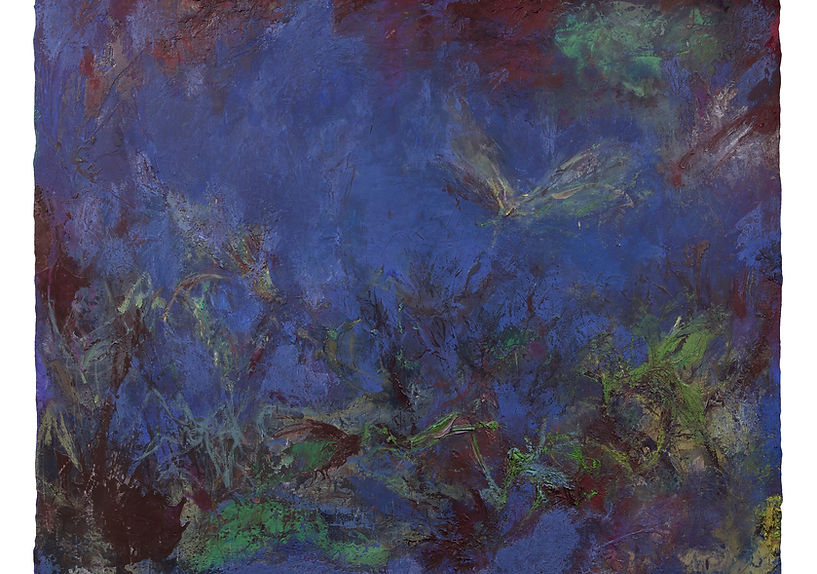
ANNE MANOLI

Born in Paris on February 24, 1961, Anne Manoli's artistic journey began in childhood, painting with her grandmother Marie Renaut. Influenced by masters like Van Gogh, Ensor, and Soutine, she pursued fine arts in 1976, developing a passion for expressionist and matierist styles. At the Ecole Nationale Supérieure des Beaux-Arts de Paris, under Louis Nallard's mentorship, she evolved, drawing inspiration from De Staël and moving towards abstract expressionism after encountering De Kooning, Pollock, and Klein. Manoli graduated in 1983, her style marked by almost monochrome canvases with organic forms, and debuted her first solo exhibition in 1984.
BIOGRAPHY
Anne Manoli was born in Paris on 24 February 1961. She realised very early on that painting would be her favourite medium for celebrating the nature that had left such a strong impression on her from childhood. She began painting with her grandmother, Marie Renaut. In 1976, she decided to study fine arts. Fascinated by the work of Van Gogh, Ensor and Soutine, she painted series of expressionist, matierist crowds and portraits. In 1980 she entered the Ecole Nationale Supérieure des Beaux-Arts de Paris in the studio of the painter Louis Nallard, who encouraged her. Nallard's tellurism and an exhibition of De Staël reinforced her attraction to matter. The discovery of De Kooning, Pollock and Klein gradually freed her from expressionist figuration. She graduated from ENSBA in 1983 with a series of almost monochrome canvases, featuring organic, diaphanous forms and broad flat tints, and had her first solo exhibition in 1984.
In 1985-1986, she continued her work by engraving directly into the paint, reminiscent of Egyptian and Syrian bas-reliefs, which brought her closer to her father, the Egyptian-born sculptor Pierre Manoli. She was also enthusiastic about the work of Kieffer and Barcelo. In 1988, she sought out new spaces through various collages and superimposed canvases, including "Pour qui les continents" and "Naissance de la baleine". Her palette became darker with "Mangeur d'étoiles". In 1990, she freed herself in a series of "Grandes Vasières" and "Petites Nos", in which she rediscovered the jubilation of the mud of her childhood. From this original crucible, Anne Manoli produced the series "Muraille Végétales" (1996) and "Transmutations" (1997), which express her obsession with the alchemy of decomposition. In 1998, animals such as the ox and the monkey merged in his painting ploughs.
The painter Astolfo Zingaro discovered her work and put her in touch with the gallery owner Nicolas Deman, who offered her a fruitful collaboration: several solo exhibitions followed, "Migrations", "Chrysalides", "Après la pluie", from 1999 to 2002; colour and gesture intensified. In London, when she came across the works of Kossoff and Auerbach, she fully realised that painting transmits a vital energy. In 2003, at the instigation of Marion and Yves Guigon, the artist created large-format works in which she depicted the four natural elements in "Grandes tourbières", "Marée blanche", "Grand lapilli" and "Asphodèles".
2004-2005: Anne Manoli began a series of "Terres d'eaux", landscapes with horizontal lines that repeat like the ripples of the tides. In Normandy, the verticality of the cliffs gave rise to a series of canvases, small pieces of earth with a mineral and fragile appearance, exhibited at the Galerie Guigon "Verts presque tendres" in 2010. From then on, the painter focused on the "canvas object", the pattern formed by the paint escaping from the frame: first she consolidated it, then she affirmed it: the overflow of paint was no longer the result of the gesture but a prior construction. "The 'painting object' becomes increasingly tactile, with the edges drawn and sculpted in this way giving the impression of an extraction, a tearing away.
In 2013, Galerie Mézières presented a monograph entitled "La Passagère", as well as an exhibition of a series of canvases, a mise en abîme of a piece of land (an island) where time erodes the surface. The light has become matt, diffusing a more muted energy. Pursuing the 'mineralisation' of painting, his work is akin to cave art and frescoes.
2016 saw the resumption of his collaboration with gallery owner Nicolas Deman, who injected a new energy into his work and exhibited: In 2017, "Sauvage est le Vent" ("Wild is the Wind"), four large-format works in praise of the four great moments of a day or a year; in 2018, "Les moires" ("The Moire"), Anne Manoli creates a subterranean world of circulating, mutating forms between two surfaces, bringing out islands of matter in their trajectories while connecting them; a metaphor for painting, which for the painter is a living organism.
The last series, "La laboureuse" (The labourer) 2023, is an allegory of the creative process, an immersion in matter where I highlight the physicality of the pictorial layer and assert that painting is anything but an image.



